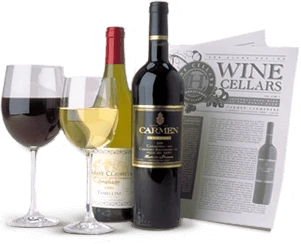Under Christian Veyry’s ownership, Château Louvie continues its meteoric rise. A stellar performance in the exceptional 2015 vintage has imbued the dense, full-bodied 2015 Château Louvie Saint-Émilion Grand Cru (80% Merlot, 20% Cabernet Franc) with everything one can expect from a top notch Saint-Émilion Grand Cru. Deeply colored, seductively aromatic, and rich in flavor, this opulent red offers compelling notes of woodland berries, cassis, dark fruits, cedar, and chocolate. Impressive even now in its youth, the 2015 Château Louvie Saint-Émilion Grand Cru is destined for greatness. Sensual, yet structured, this bold-flavored wine will evolve in the glass for hours. For optimal enjoyment we suggest decanting the 2015 Château Louvie Saint-Émilion Grand Cru for at least an hour before serving at cool room temperature (58°-62° F). Enjoy!
The concentrated, full-bodied 2015 Château Louvie Saint-Émilion Grand Cru provides superb companionship to simple, well prepared dishes as well as complex gourmet fare, which makes it the consummate choice for an elegant dinner party. Prime Rib, served au jus, affords Château Louvie’s wonderful Saint-Émilion Grand Cru an ideal companion with which to shine. When served with mashed potatoes, fresh green beans, and braised pearl onions, it will be hard to resist the 2015 Château Louvie or the Prime Rib. A bone-in veal chop prepared with a tasty brown sauce offers another delicious accompaniment. Plump roasted chickens and game hens served with wild rice or an onion and sage stuffing offer more palate pleasing accompaniments. And for those who save the best for last and are disciplined enough to have bit of Château Louvie’s 2015 Saint-Émilion Grand Cru left in their glasses, we suggest they drain those glasses in the company of a selection of French cheeses that include Cantal and Port Salut. A votre santé!
Château Louvie is a postage stamp of a vineyard nestled on a tiny plateau and its gentle hillside slopes in the Saint-Émilion district of Saint Laurent des Combes. With ideal exposure and well-drained soil, this diminutive estate, owned by Christian Veyry, produces superlative, highly sought after Saint-Émilion. A winemaker and consultant-oenologist who collaborated with the legendary Bordeaux icon Michel Rolland, Christian now consults for numerous famous châteaux in Bordeaux and Cahors. He is also the owner of Château Veyry in nearby Côtes de Castillon, an ancient wine region that is vying to be Bordeaux’s next star.
Since the last half of the 20th century, Merlot has lived in the shadow of its younger, more robust sibling, Cabernet Sauvignon. Both Merlot and Cabernet Sauvignon are traditional French varietals whose origins are attributed to Bordeaux. However, after the 19th century phylloxera scourge in France, Merlot lost some of its prominence in Bordeaux and elsewhere in favor of the thicker skinned, more age worthy Cabernet Sauvignon. Merlot came to be viewed as the bridesmaid rather than the bride, and it found itself in a supporting role in many wine regions rather than as the star of the show. This phenomenon occurred in spite of the fact that many of Bordeaux’s greatest red wines have for centuries been produced primarily from Merlot, and they continue to be. The great Château Petrus remains Bordeaux’s most expensive wine and nearly all of the finest wines of Saint-Émilion are based essentially upon Merlot. However, Bordeaux is not the only wine region today where Merlot thrives. From its native France, Merlot has traveled the world. It is now cultivated on six continents and has over the last three decades become a staple in California, Australia, South Africa, South America, and Tuscany, not to mention its recent proliferation in southern France and throughout Europe. Moreover, Merlot is a very prolific grape variety when left to its own devices. Consequently, nearly everywhere it is cultivated, severe pruning is the key to the quality quotient with this varietal. Merlot suffers from a susceptibility to spring frosts and a very thin skin, too, which leaves it open to rot. Nonetheless, where conditions are warm and dry and the soil is well drained, Merlot thrives. So, no more is the venerable Merlot vine the perennial bridesmaid.
Although reluctant to rely on gender stereotyping of grape varietals or their particular characteristics, a compelling case can be made for describing Cabernet Franc as the feminine side of Cabernet Sauvignon. Cabernet Franc, whose origin appears to be the Pyrenees Mountains in southwest France, is one of Bordeaux’s oldest and most prestigious grape varietals. It predates Cabernet Sauvignon by many centuries and recent DNA testing has determined that Cabernet Franc and Sauvignon Blanc constitute the actual forebears of Cabernet Sauvignon and not the other way around.
In its spiritual home of Bordeaux, Cabernet Franc figures prominently in both Left and Right Bank wines, with the most esteemed Right Bank appellations of Pomerol and Saint-Émilion relying more heavily on Cabernet Franc’s propensity to ripen earlier than its more famous offspring, Cabernet Sauvignon. Add Cabernet Franc’s hauntingly beautiful fragrance, enticing berry, currant and leafy flavors, along with rounder, more accessible tannins than its progeny, Cabernet Sauvignon, and it is easy to see why Cabernet Franc is uniformly esteemed in Bordeaux and increasingly sought after by New World wineries.

Enjoy Limited Production Estate
Bottled Wines
Discover limited production estate bottled wines such as Vergenoegd's internationally
acclaimed 2005 Cabernet Sauvignon, imported exclusively for our members.

